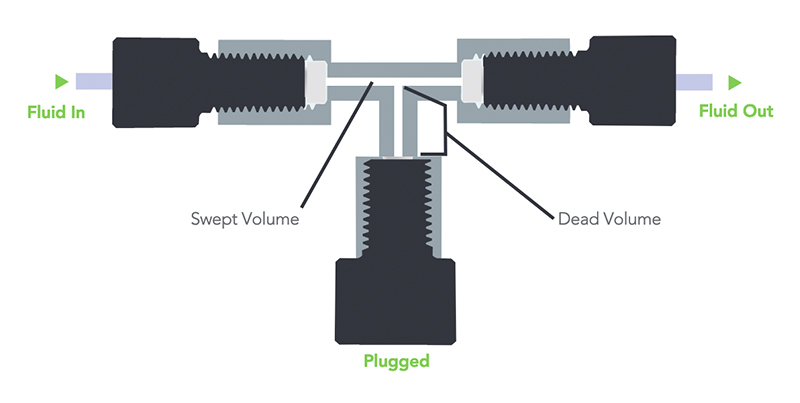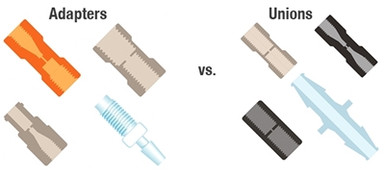Posted by Chrom Tech on 15th Oct 2025
What Is the Difference Between a Union and an Adapter in HPLC?
In high-performance liquid chromatography (HPLC), maintaining tight, leak-free connections is essential for accuracy and reproducibility. Two of the most common connection components are unions and adapters. While they may appear similar, each serves a distinct function within your chromatography system. Understanding when to use one over the other helps prevent leaks, reduce dead volume, and optimize system performance.
Unions vs. Adapters in HPLC
Unions are used to connect two pieces of tubing or components with the same thread or port configuration on both sides—for example, a 1/4-28 or 10-32 thread. Because they maintain consistent geometry, unions are generally more cost-effective and simpler to install than adapters.
Adapters, on the other hand, connect dissimilar port geometries or thread types—such as transitioning from a male 1/4-28 connection to a female 10-32 port, or from a barbed fitting to a threaded connection. Adapters are especially useful when connecting components from different systems or when port configurations vary.
Chrom Tech offers a comprehensive selection of HPLC accessories, including adapters, unions, and connectors such as barbed Y-connectors, T-connectors, and male-to-female fittings to suit both low- and high-pressure applications.
How to Choose the Right Union or Adapter
When selecting a union or adapter, the first consideration should always be the pressure rating of your connection.
1. Determine Pressure Type
If you are connecting two pieces of tubing, the connection’s pressure limit will be defined by the softer tubing in the pair. For example, if connecting 1/16” OD PEEK tubing to 1/8” OD FEP tubing, the overall connection is limited to approximately 500 psi, since FEP is softer and less pressure-resistant.
2. Match the Thread Geometry
For low-pressure connections, a common choice is the 1/4-28 flat-bottom union, which fits both 1/8” and 1/16” OD tubing. Even when connecting two different tubing diameters, if both can accept a 1/4-28 thread, a standard union will typically be the simplest and most economical option.
In some cases, when port geometries differ, an adapter may be required instead. However, unions should always be considered first, as they minimize cost, potential dead volume, and complexity.
3. Consider Dead Volume
When choosing fittings, unions, or adapters, it’s important to understand how internal volume affects system performance. While users often refer to “dead volume,” what they truly want to minimize is the unswept internal space that causes mixing or dispersion of the sample.
Dead Volume vs. Swept Volume vs. Void Volume
Void Volume represents the total internal volume inside a connection—any space that fluid can enter. It can be divided into:
- Swept Volume: The portion of the void volume directly in the flow path.
- Dead Volume: The portion of the void volume outside the flow path, where fluid stagnates.
VOID VOLUME = SWEPT VOLUME + DEAD VOLUME
Excess dead volume can lead to undesirable chromatographic effects, such as:
- Peak broadening
- Reduced resolution
- Sample carry-over
- Split or distorted peaks
To minimize these effects, Chrom Tech recommends using Zero Dead Volume (ZDV) unions whenever possible. Additionally, matching your tubing’s internal diameter (ID) to the fitting’s through-hole helps reduce turbulence and maintain consistent flow.
Summary
In summary, unions are ideal when connecting components with identical ports, offering a simple, economical solution with minimal dead volume. Adapters are used when port geometries differ or when transitioning between thread types or tubing sizes. Choosing the correct component improves system integrity, reduces leaks, and enhances chromatographic performance.
For help selecting the proper fittings, unions, or adapters for your HPLC setup, please contact Chrom Tech. Our technical team is ready to help ensure reliable, high-performance connections across your HPLC system.
Frequently Asked Questions About HPLC Unions and Adapters
What is the difference between a union and an adapter in HPLC?
A union connects two components with the same thread or port type, while an adapter connects components with different geometries or thread sizes. Unions are typically more cost-effective and create less dead volume.
When should I use an adapter instead of a union?
Use an adapter when the connection involves different thread types, port geometries, or tubing sizes that a standard union cannot accommodate—for example, converting from 10-32 to 1/4-28 threads or from barbed to threaded fittings.
How can I reduce dead volume in my HPLC system?
Minimize dead volume by using zero dead volume (ZDV) unions, matching tubing IDs to fitting through-holes, and avoiding unnecessary adapters or long connections. This helps maintain sharp peaks and consistent chromatographic results.

